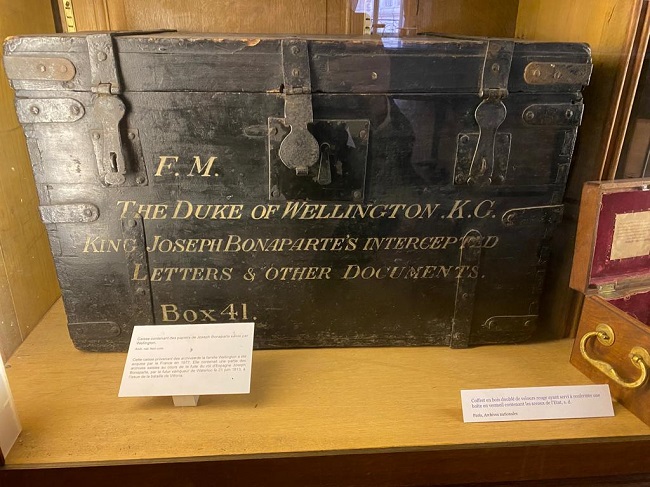Carnet de Voyage: a Dive into the Archives

Travel notes from the real France. Carnet de Voyage is a weekly personal travel story in France sent in by readers. If you’d like to write a story for Carnet de Voyage, head here for details on how to submit.
Walking to a coffee date on a damp November day in the Marais quartier in Paris, I was struck by the vast building my husband and I were walking by, in that it loomed up high above us with no windows or doors, almost like a prison. Suitably piqued we realised the answer lay in the road name – Rue des Archives. As we turned the corner, a sudden shower pushed us into finding shelter (of course I had, as usual, forgotten the umbrella) and we found ourselves outside the courtyard of Les Archives Nationales where the gateway gave us respite from the rain, but also revealed a site we hadn’t yet discovered.
After our coffee we returned to learn more. The cour d’honneur bordered by a covered portico on two sides, was housing a temporary photo exhibition dedicated to 50 years of Libération, the newspaper founded by Jean Paul Sartre and Serge July in 1973. Some amazing photos, posters and reproductions of the paper’s cover kept us strolling and stoked our memories as the exhibition leads one through some of the major social, cultural and political events over the last 50 years. We then noticed that entry to the “Museé des Archives Nationales” itself is free so went inside for a peek, where the real treat lies.

© Ruth Roberts
The building’s origins, a private palace, date back to 1553 and in 1700 it was acquired by Francoise de Rohan-Soubise who undertook its beautification. In 1808 it was purchased by the State by imperial decree and Napoleon I ordered that the National Archives preserved since the Revolution, be regrouped centrally and stored in the Hotel de Soubise.
A first room after the lobby includes several display cases with some incredible documents, whether what we were looking at were reproductions or originals is irrelevant, as the historical value provides the wow factor. Our favourites were the overview of France’s accounts from the year 1783 to include Louis XVI’s annual revenue, the gross import, export and production worth and also a recapitulative of “Europe’s” military status – at the time of course Austria had the largest military army but Britain by far the most powerful navy. We also enjoyed seeing the first issue and layout of the “Déclaration des Droits de l’Homme” from 1789.
A further temporary exhibition in the magnificent stairwell took us chronologically through the key events from the storming of the Bastille to the gruesome end of Louis and his court – that period of French history relating to the founding of the République which still fascinates me, and I suspect much of the world, with excerpts from letters written by Marie Antoinette and Robespierre to name a few. We saw a model of the Bastille and also some of the original huge cast iron keys.

© Ruth Roberts
Whilst we did not have time to explore the whole museum the reception rooms of the palace are glorious enough to wander through and one can see how the archives were stored, how they were moved and transported (on the backs of clerks with specific carrying contraptions) and examples of ancient leather-bound embossed ledgers and archive boxes, yellowed with age, in glass plated armoires. We were fascinated to see an old chest, returned to France only in 1977, belonging to the Duke of Wellington and containing intercepted letters and documents from King Joseph Bonaparte.
We will definitely go back for a more prolonged visit and perhaps aim to time it during the Journées de Patrimoine when I believe there may be exceptional access to the original archive rooms.
Read our other Carnet de Voyage entries here.

© Ruth Roberts
Lead photo credit : Les Archives Nationales © Ruth Roberts
Share to: Facebook Twitter LinkedIn Email
More in Carnet de Voyage, French history, museums in France, Paris, Paris museums
By Ruth Roberts
Leave a reply
Your email address will not be published. Required fields are marked *



